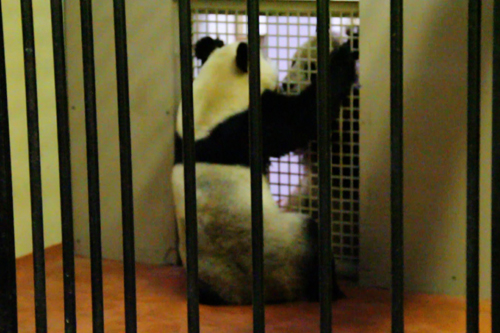FERTILITY tests have started on panda Tian Tian to see if she is ready to mate with her partner at EdinburghZoo.
The test results allow staff at the zoo to judge the right time to put Tian Tian together with Yang Guang in the hope of producing panda cubs.
Last year the pair’s first mating season together attracting worldwide interest but ended in disappointment.

The “all important” tests will see whether the pandas’ hormone cycles match.
It is believed Tian Tian’s season will arrive between March and May and will only last around 36 hours making the tests crucial.
Iain Valentine, director of the giant panda project and strategic innovations at the zoo, said: “Although there is no guarantee of panda cubs this year, we now have more confidence in our understanding of panda breeding.
“Although The Royal Zoological Society of Scotland is a global leader in the science and art of animal care, panda breeding by its very nature is not always straightforward – but hugely rewarding.
“Taking the vast amount we learned from our first panda breeding season in 2012, we are already implementing this knowledge in the lead up to 2013’s panda breeding season.”
Various factors such as rising temperatures, the length of daylight and food availability are all considered to have an impact on mating pandas.
Pandas are famously rare because of their sensitivity to breeding conditions and the short, restricted period where they can breed together.
The zoo is planning to increase enclosure swapping this year in hope that the pandas – Sunshine and Sweetie in English – will smell each other more often and know they are both sexually mature.
Mr Valentine added: “There will be a huge focus on working to synchronise Tian Tian and Yang Guang’s hormone cycles.
“As seasonal breeders, panda hormones are dictated by light levels. The indoor lighting levels in their enclosures now simulate those of natural light levels: in line with sunrise and sunset.
“We will also be increasing enclosure swapping, allowing both pandas the opportunity to smell each other’s scent but also giving them opportunity to scent mark in each other’s enclosures,” he said.
Mr Valentine said this was a “vital aspect” of their work.
He said: “The male can tell when the female is coming into season by the change in her scent and the female can tell if the male is sexually mature and capable of breeding by his scent and scent-making skills.”
The pandas arrived in Edinburgh after being flown over from the Ya’an reserve in Chengdu, China in December 2011.
However, in 2012 they failed to mate after Tian Tian’s hormone levels dropped and became too low to mate.
The pair showed interest in each other at the time – sometimes taking the form of wrestling – but failed to mate successfully.
They were brought together through a “love tunnel” which allowed them to see and touch each other from the their two enclosures.
Tian Tian and Yang Guang are part of a 10-year deal said to cost £6million while a Scottish Enterprise report found the pandas giving the Scottish economy with £4million a year.
They are the first pandas to be brought into the UK in 17 years.